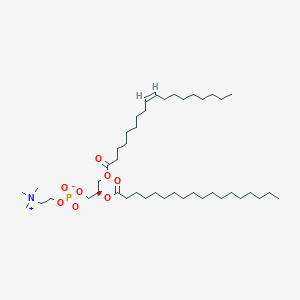| MeSH term | MeSH ID | Detail |
|---|---|---|
| Lyme Disease | D008193 | 5 associated lipids |
1-oleoyl-2-stearoyl-sn-glycero-3-phosphocholine
1-oleoyl-2-stearoyl-sn-glycero-3-phosphocholine is a lipid of Glycerophospholipids (GP) class. 1-oleoyl-2-stearoyl-sn-glycero-3-phosphocholine is associated with abnormalities such as Lyme Disease, Syphilis and neuroborreliosis. The involved functions are known as phosphoglycerate dehydrogenase activity, Antibody Formation, Immune response and Antigenic Diversity. 1-oleoyl-2-stearoyl-sn-glycero-3-phosphocholine often locates in Flagella, IgG antibody and IgM immunoglobulin complex, circulating. The associated genes with 1-oleoyl-2-stearoyl-sn-glycero-3-phosphocholine are synthetic peptide, Homologous Gene and Genome. The related lipids are 1-oleoyl-2-stearoylphosphatidylcholine.
Cross Reference
Introduction
To understand associated biological information of 1-oleoyl-2-stearoyl-sn-glycero-3-phosphocholine, we collected biological information of abnormalities, associated pathways, cellular/molecular locations, biological functions, related genes/proteins, lipids and common seen animal/experimental models with organized paragraphs from literatures.
What diseases are associated with 1-oleoyl-2-stearoyl-sn-glycero-3-phosphocholine?
1-oleoyl-2-stearoyl-sn-glycero-3-phosphocholine is suspected in Lyme Disease, Syphilis, neuroborreliosis and other diseases in descending order of the highest number of associated sentences.
Related references are mostly published in these journals:
| Disease | Cross reference | Weighted score | Related literature |
|---|
Possible diseases from mapped MeSH terms on references
We collected disease MeSH terms mapped to the references associated with 1-oleoyl-2-stearoyl-sn-glycero-3-phosphocholine
PubChem Associated disorders and diseases
What pathways are associated with 1-oleoyl-2-stearoyl-sn-glycero-3-phosphocholine
There are no associated biomedical information in the current reference collection.
PubChem Biomolecular Interactions and Pathways
Link to PubChem Biomolecular Interactions and PathwaysWhat cellular locations are associated with 1-oleoyl-2-stearoyl-sn-glycero-3-phosphocholine?
Visualization in cellular structure
Associated locations are in red color. Not associated locations are in black.
Related references are published most in these journals:
| Location | Cross reference | Weighted score | Related literatures |
|---|
What functions are associated with 1-oleoyl-2-stearoyl-sn-glycero-3-phosphocholine?
Related references are published most in these journals:
| Function | Cross reference | Weighted score | Related literatures |
|---|
What lipids are associated with 1-oleoyl-2-stearoyl-sn-glycero-3-phosphocholine?
Related references are published most in these journals:
| Lipid concept | Cross reference | Weighted score | Related literatures |
|---|
What genes are associated with 1-oleoyl-2-stearoyl-sn-glycero-3-phosphocholine?
Related references are published most in these journals:
| Gene | Cross reference | Weighted score | Related literatures |
|---|
What common seen animal models are associated with 1-oleoyl-2-stearoyl-sn-glycero-3-phosphocholine?
There are no associated biomedical information in the current reference collection.
NCBI Entrez Crosslinks
All references with 1-oleoyl-2-stearoyl-sn-glycero-3-phosphocholine
Download all related citations| Authors | Title | Published | Journal | PubMed Link |
|---|---|---|---|---|
| Martinez-Seara H et al. | Why is the sn-2 chain of monounsaturated glycerophospholipids usually unsaturated whereas the sn-1 chain is saturated? Studies of 1-stearoyl-2-oleoyl-sn-glycero-3-phosphatidylcholine (SOPC) and 1-oleoyl-2-stearoyl-sn-glycero-3-phosphatidylcholine (OSPC) membranes with and without cholesterol. | 2009 | J Phys Chem B | pmid:19469492 |
| Diculescu VC et al. | Interaction of imatinib with liposomes: voltammetric and AFM characterization. | 2009 | Bioelectrochemistry | pmid:19119081 |
| Soni SP et al. | Effect of trans unsaturation on molecular organization in a phospholipid membrane. | 2009 | Biochemistry | pmid:19817487 |
| Tada K et al. | Barotropic and thermotropic bilayer phase behavior of positional isomers of unsaturated mixed-chain phosphatidylcholines. | 2009 | Biochim. Biophys. Acta | pmid:19233121 |
| Earnhart CG et al. | Development of an OspC-based tetravalent, recombinant, chimeric vaccinogen that elicits bactericidal antibody against diverse Lyme disease spirochete strains. | 2007 | Vaccine | pmid:16996663 |
| Jerlich A et al. | The formation of phosphatidylcholine oxidation products by stimulated phagocytes. | 2003 | Free Radic. Res. | pmid:12868491 |
| Mathiesen MJ et al. | Peptide-based OspC enzyme-linked immunosorbent assay for serodiagnosis of Lyme borreliosis. | 1998 | J. Clin. Microbiol. | pmid:9817857 |
| Mathiesen MJ et al. | Analysis of the human antibody response to outer surface protein C (OspC) of Borrelia burgdorferi sensu stricto, B. garinii, and B. afzelii. | 1996 | Med. Microbiol. Immunol. | pmid:9007816 |
| Redgrave TG et al. | Effects of sphingomyelin and phosphatidylcholine acyl chains on the clearance of triacylglycerol-rich lipoproteins from plasma. Studies with lipid emulsions in rats. | 1992 | Biochim. Biophys. Acta | pmid:1606176 |
| Hamilton KS et al. | Phase behaviour of amphotericin B multilamellar vesicles. | 1991 | Biochim. Biophys. Acta | pmid:1848451 |
